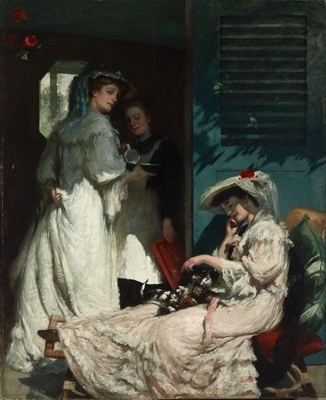
Description
Salon painting as a precept and as a practice had no more loyal adherent than Rupert Bunny. Born and educated in Melbourne, Bunny began a lifetime of European travel and residence in 1884. The success of his academic and essentially escapist project in Paris and London was real, complicit though it proved to be with the self-delusion of an age on the edge of war. Bunny's dedication to the good life resulted in some of the most sumptuous paintings in Australian art history, and the most admired. The artist's wife, kittenish herself, plays with a lapful of cats. Her companion accepts a basin of milk from a meaningfully shadowed maid. As upholstered in privilege as they are in their lacy day-gowns, Bunny's women are the late-picked fruit of a century whose heyday had passed. Despite his stylistic conservatism, the painter kept a finger on the pulse of taste. He responded to post-impressionism and fauvism, albeit belatedly, in a series of brilliantly coloured compositions on classical themes in the 1920s. During that decade, Bunny returned twice to Australia, settling permanently in 1933. Music, in which he had always had a parallel interest, became increasingly important to him: even so palpable a painting as 'A summer morning', with its plump depictions of fabric and flesh, has a musical ethereality.
Details
- Work Date:
- circa 190
- Location:
- 19th c Australian art
- Dimensions:
- 222.0 x 181.5 cm stretcher; 246.3 x 205.7 x 13.0 cm frame
- Medium:
- Oil on canvas
- Credit Line:
- Purchased 1911